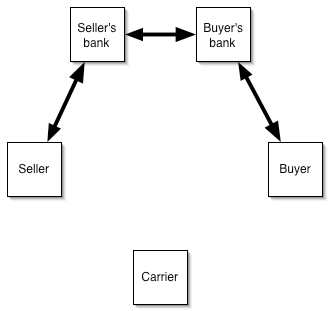The development of trade and economic relations led to the emergence of an adequate financial system. A letter of credit is one of the most reliable when it comes to foreign trade transactions. However, among the participants in the process, it is not particularly popular. Let's see why.
Definition
A letter of credit is an obligation of a financial institution to pay for goods to a supplier on behalf of a client. The transfer will take place if documents are provided that confirm the shipment of the goods in full and on time. A letter of credit is approved by a separate sales contract. In such operations, participants deal only with securities.
Advantages of a letter of credit form of payment:
- protection of interests of the parties, guarantee of delivery of goods on time;
- bank security for payment of goods;
- opportunity to avoid prepayment;
- money back guarantee to the buyer if the goods were not delivered.

Kinds
The letter of credit of the revocable type of payment may be changed or canceled without the prior consent of the beneficiary (beneficiary). The main advantage of such a document is the quick payment. But it is used only if the parties trust each other. An irrevocable letter of credit may be changed only with the consent of the beneficiary.
Payment Methods
- Upon presentation. Money is paid to the beneficiary after the bank checks the documents submitted to him. Such type of settlement called "payment against the document."
- Based bill of exchange. According to the terms of the import letter of credit, it is determined that the issuing bank fulfills its obligations by accepting a draft. After checking the documents, the financial institution confirms the bill, and on the day of payment transfers the funds in favor of the beneficiary to the details received from the foreign partner.
- The letter of credit installment payment method obliges the issuing bank after receiving the documents to conduct the transaction within the specified time.
Turnover Scheme:
- Participants in the transaction sign an agreement with a letter of credit.
- The buyer submits the application.
- The issuer notifies the advised bank of the opening of the letter of credit.
- The seller ships the goods.
- TTN are transferred to the advised bank.
- Payments are made to the seller.
- TTNs are sent to the issuing bank.
- The buyer pays for the goods and receives the documents.
Let us dwell briefly on the features of the preparation of the document and the basic terminology:
- “Deadline for shipment” - no later than the end date of the letter of credit.
- "Applicant" - the name of the company, address and telephone number.
- “Beneficiary” - name and contact details of a foreign partner.
- Amount ”is indicated in numbers and in words with the name of the currency.
- “Beneficiary's Bank” - details of the institution that serves the foreign partner.
Disadvantages of a letter of credit
These include the following:
- the bank may check the documents for several weeks;
- if the buyer refuses to pay, the seller will bear all the costs associated with the storage, sale of goods or their transportation to their country.
Import of goods
Purpose of using an import letter of credit:
- maximum risk reduction in case of failure to comply with the terms of the transaction;
- financing contracts at low rates of the international financial market (the importer receives a loan to cover, and the Russian bank funds the money from foreign organizations for this).
The client pays a commission to the bank for processing documents,% of the loan and margin.
Circulation of documents:
- opening of current and currency accounts by a client at a bank;
- registration of an import transaction passport;
- - filing an application for opening a letter of credit;
- - financing of the transaction.
The letter of credit of international settlements has the following advantages for importing clients:
- payment is made after receiving documents confirming the shipment of the goods;
- when working with new or unverified customers, there is no need to make an advance payment;
- all documents are checked at the bank;
- in the absence of funds to finance the supply, the client can get a loan at low international rates;
- minimum package of documents (only applications for opening a letter of credit);
- coverage is formed in rubles, i.e. there are no currency risks.
Export of goods
Purpose of using export letter of credit:
- Maximum risk reduction for non-fulfillment of contract terms.
- The ability to provide deferment to the buyer.
A bank client pays only a commission to the bank for paperwork.
The letter of credit of non-cash payments has the following advantages for exporters:
- payment for delivery is guaranteed by the bank;
- there is no need to provide commodity credit;
- the exporter receives payment in a short time and can invest in working capital;
- the opportunity to expand markets and attract new partners.

Letter of credit form of payment: scheme
The algorithm of actions is as follows:
- signing a contract with a partner;
- filing an application for opening a letter of credit;
- document sight;
- Shipment of goods;
- transfer of documents to the bank;
- TTN check;
- transfer of the document to the buyer's bank;
- payment for goods;
- receipt of documents by the buyer.

A letter of credit is used when purchasing:
- apartments, land;
- shares in LLC;
- stocks;
- payment for goods.
Example
The management of the company, which sells European clothing on the domestic market, decided to buy a batch of goods from a new foreign supplier. The contract price is 1 million rubles. To confirm the order, an advance payment of 30% is required. The company does not have enough own funds. Therefore, the management entered into a contract for a letter of credit form of payment and applied to the bank with a corresponding statement. A deposit opened with a Russian bank was used as security for payment. Commission of a financial institution - 0.7% of the transaction amount. The supplier shipped the goods and presented the documents for payment to the financial institution. Then, TTN were sent to a domestic bank, which deducted funds from the customer’s deposit and refunded the payment.
Alternative option
Letter of credit is also used for post-import financing. A foreign bank makes a payment to the seller, providing a deferment to the Russian financial institution, which also postpones the payment date to its client. Such operations may be beneficial to organizations that need borrowed funds in the implementation of foreign trade activities,
Settlement Procedure:
- the client opens current and currency accounts;
- an import contract is signed, which provides for the use of a letter of credit;
- issued transaction passport, in accordance with the requirements of the legislation of the Russian Federation;
- the client applies for a letter of credit;
- the import bank pays the delivery to the seller after the shipment of the goods, provides a delay to the Russian financial institution, which also postpones the payment date for its client.
The advantages of such a scheme for buyers:
- the ability to fulfill obligations without attracting own funds;
- lower cost of financing (compared to a loan), since the transaction is paid for in foreign currency;
- when concluding a loan agreement, a single interest rate is established;
- minimal currency risks;
- the ability to work with suppliers from any country;
- reduction of commercial risks;
- flexible loan repayment schedule.

This scheme is used to pay for purchases:
- raw materials;
- consumer goods;
- machinery, production equipment;
- spare parts, components;
- results of intellectual activity, etc.
Importer pays for:
- deferral cost in a foreign bank;
- the margin of a Russian credit institution;
- Bank commission for letter of credit.
| Calculation of the cost of financing for the buyer | |
| Indicator | Value |
| Foreign Bank Financing | EURIBOR 3m + 1% |
| Credit margin | 3 % |
| Commission for opening a letter of credit (one-time) | 0,5 % |
| Total | EURIBOR 3m + 1% + 3% + 0.5% |
Even without EURIBOR 3m, the importer will have to pay a minimum of 4.5% for an international loan. Although the fee for using borrowed funds is less than in standard schemes, not every organization will agree to give such money. If the delivery amount is small, then it makes sense to accumulate own funds. Such a scheme will also not work if the buyer needs the goods urgently. The confirming party may check the documents for several weeks. These shortcomings of the letter of credit form of settlement narrow down the circle of potential consumers of the service.

Banker Tips
The essence of the operation lies in the fact that upon the applicant’s appeal, the institution acts as a guarantor of payment for products if a package of documents is provided. Counterparties who collaborate for the first time can thus protect their interests. For settlements, banks use the client’s money in the account or other liquid assets.
A letter of credit is called covered if, immediately after receiving the application, a financial institution reserves 100% of the funds in the client’s account. In this case, together with the application is submitted payment order. If an open letter of credit is applied, the issuer guarantees payment, even if the client does not have money in the account. By default, the first scheme is used. It is less risky for the bank, so it costs less.
If the contract stipulates the delivery of goods in batches, it is more advisable to open a divisible letter of credit, indicating in the document the condition "partial shipments are allowed." The cost of the contract with the bank should not be less than that indicated in the documents with the supplier. Payments are made in installments in accordance with the provided securities.
With the same type of shipments and planned payments, banks use a revolving (renewable) form of payment, which helps customers save on maintenance, since the commission is calculated based on a one-time delivery. But a financial institution may request security based on the full amount of the contract.

There are no legislative restrictions on the use of letters of credit. But the internal rules of the bank indicate the conditions for the amounts, currency or subjects of payment relations. Terms are limited by the contract between the supplier and the buyer. The currency of the letter of credit is determined by the availability of correspondent accounts with the correspondent bank. Under foreign economic contracts, they work more often in dollars and euros or in pounds sterling. Inside the country, all payments are in national currency. It is not possible to make a payment between states or legal entities subject to financial sanctions.
Summary
A letter of credit is the most reliable form of settlement in foreign trade transactions, which will reduce commercial and currency risks, and also guarantees payment for goods by the buyer. Depending on the form and type of the issued document, the payment can be taken into account by draft, secured by a deposit or carried forward for a certain period. By accepting the document, the bank gives a written obligation to transfer money to the client’s account in another country. The basis for the transfer is documents confirming the fact of shipment of goods.








